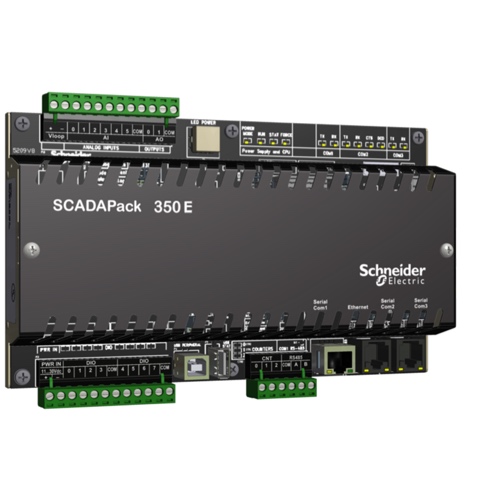SCADAPack 350E

SCADAPack™ Smart RTUs combine the communication and monitoring capabilities of an RTU with the processing and data-logging power of a PLC. They are ideal for remote processes that require automatic supervision and autonomous control. They are designed for the harsh conditions associated with remote sites in applications such as oil and gas and water and wastewater facilities.
**SCADAPack 350 E Series is obsolete and being replaced with SCADAPack 400 Series
SCADAPack™ 350 E is a microprocessor-based telemetry and control device designed with extensive communications capabilities including Ethernet and USB interfaces and an embedded micro-controller. The on-board switch mode power supply allows a wide range of voltage operation from a single external voltage supply. The use of FLASH memory chips allows new firmware to be downloaded locally and remotely via the interfaces of the RTU, without removing it from its enclosure. RTU configurations are maintained in the on-board, battery-backed RAM and may be modified locally or remotely. The SCADAPack 350 E includes one Ethernet port and three serial ports that are available for communications with the SCADA master system, with other RTUs, with PLCs and with the local configuration software. It also includes two USB 2.0 compliant device ports for local configuration and to connect to other devices.
SCADA: Learning the Basics
Supervisory Control and Data Acquisition (SCADA) systems are a combination of both hardware and software that allows monitoring of various devices that provide information about specific environments or processes. This information is transmitted through logic controllers, or other smart devices, and is sent to software interfaces known as an HMI, where the information is displayed in a way that individuals can read and interpret the data. SCADA is not only used for monitoring, it is also used for control. Through SCADA, it is possible to manipulate, move, or change the state of certain devices on the network. For example, it is possible to initiate a command through the HMI software that will energize or de-energize a solenoid valve, thus changing its state. In most scenarios, there are dozens, hundreds, or even thousands of points throughout a location or multiple locations that are being monitored and controlled through SCADA. SCADA systems can be found in many different industries such as telecommunications, water and wastewater, energy, oil and gas refining and transportation. These systems can be used to monitor and control only a few simple points, or can be used in massive energy plants where tens of thousands of data points are being interpreted and controlled every minute.
Hardware used in SCADA systems include:
- PLCs, which can act as a bridge between the hardware and software, as well as providing data transmission and network communications.
- Field monitoring and control devices, such as limit switches, temperature transmitters, pressure transmitters, solenoid valves, chemical monitoring devices and motor starters.
Software used in SCADA systems include:
- HMI or Human Machine Interface software receives data throughout the system and organizes it in a way that can be easily interpreted. It can also provide control based on the information it receives.

